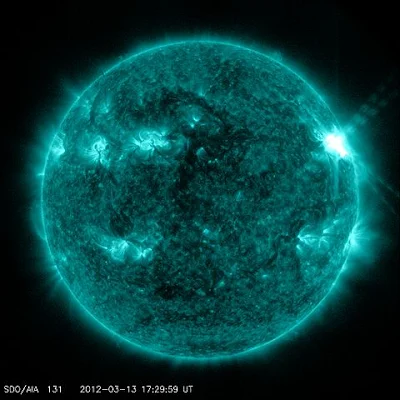45 Interesting Facts About the Sun
- The sun is the only star at the center of the solar system. It contains about 99.86% mass of this whole system.
- Sun is at the higher end of the group of stars called yellow dwarf stars. They generally last for 10 billion years. (Source)
- The sun and planets of the solar system were formed from a molecular cloud. This cloud was the product of a massive concentration of interstellar gas and dust. (Source)
- All the planets and other celestial objects orbit the sun in the same direction and plane. The same orderly movement has also been seen in other solar systems. (Source)
- The gravity on the surface of the sun is 28 times higher than the gravity on the surface of the earth. (Source)
- The age of the sun is around 4.6 billion years, while its expected remaining life is around 7 billion years.
- The color of the sun is white due to a collection of seven colors of the spectrum. It looks yellow, red, or orange because the atmosphere of the earth scatters its colors of short wavelengths (blue, green, violet). Therefore, we can only see the sun's colors of high wavelengths (yellow, orange, and red). (Source)
- The sky looks blue due to the dispersal of blue light from the sun in the upper atmosphere of the earth. (Source)
- The light we see emits from the photosphere. It is the coolest layer of the sun’s atmosphere and the only part visible from naked eye.
- The earth orbits the sun at a distance of around 93 million miles. The distance between the earth and the sun is known as AU (astronomical unit) and is used to measure other distances in the solar system. (Source)
- The sun is a ball of plasma (electrically charged hot gases) without any solid surface. It is mainly composed of hydrogen (about 70%) and helium (app. 28%).
- Sun produces radiation thanks to the process of nuclear fusion in its core. It is almost impossible to build similar nuclear reactors on earth due to a lack of gravity. (Source)
- Sun is the perfect natural sphere ever observed in the universe. An artificial sphere of silicon is the only object more perfectly spherical than this star. (Source)

Sun is the most perfect natural sphere - The sun (and the whole solar system) revolves around the center of the Milky Way Galaxy. It takes 226 million years to complete its orbit around the center of the galaxy.
- The sun is 27,000 light-years from the center of the Milky Way Galaxy. It orbits the center of the galaxy at an angle of 60 degrees with a speed of 137 miles (220 km) per second. (Source)
- The idea that the earth orbits around the sun was initially presented by Nicholas Copernicus, a Polish priest, in the 16th Century. (Source)
- In 1992, the Catholic Church recognized that the earth revolves around the sun. Previously, the Church rejected this theory for 359 years because it was against the scriptures. (Source)
- There are three main layers of the sun’s atmosphere: the photosphere, chromosphere, and corona. (Source)
- The solar corona is the outermost layer of the sun. It causes a stream of charged particles up to 900 km/h at a temperature of 1 million degrees Celsius, known as the solar wind. The solar wind separates the tails of comets from their bodies. (Source)
- Corona is the outer atmosphere of the sun, which spreads millions of kilometers around the sun. Its temperature is several times higher than the temperature at the surface of the sun. Corona is easily visible as a white crown around the sun during a complete solar eclipse.
- The sun consumes 5 million tons (5 billion kg) of nuclear hydrogen fuel every second. It has been consuming the same amount of hydrogen for the past 5 billion years and will continue the same process for at least another 4 billion years.
- Around 1.3 million earth-sized planets can fit inside the sun. This star can also accommodate nearly 1,000 objects the size of Jupiter, the largest planet of the Solar System.
- According to NASA, an explosion of 100 billion tons of dynamite every second is required to match the energy produced by the sun.
- In 2006, scientists produced extremely high temperatures in a lab that was even higher than the temperature at the core of the sun. (Source)
- Distance between the earth and the sun changes at different times of the year. The earth is closest to the sun in January, while both are farthest to each other in July every year. (Source)
- The solar energy that reaches the earth in an hour is more than the total energy consumed by the whole world in a year. (Source)

Solar energy is immense and inexpensive - Solar energy usually proves costly. However, a recent survey shows that it is the cheapest energy source in almost 60 low-income countries. (Source)
- The temperature at the surface of the sun is around 5,500 Celsius, while the temperature at its core is 15 million Celsius.
- Lightning is five times hotter than the surface of the sun. Its maximum temperature is nearly 30,000 K (53,540 F). (Source)
- Areas on the sun with strong magnetic activity appear dark due to low temperatures. These are known as sunspots. A solar flare is an explosion caused by magnetic fields near sunspots. They release a lot of radiation into space and can interfere with radio communications on earth. Solar flares and CME (coronal mass ejection) are the most powerful explosions in the solar system. (Source)
- The period between 1645 and 1715 is known as the maunder minimum due to considerably low sunspot activity. It resulted in a chilly climate in Northern Hemisphere. (Source)
- The concept of sun worship was present in several ancient civilizations and religions. These include Ancient Egypt, Mesopotamia, Ancient Greece, Roman religions, Hinduism, Buddhism, Native Americans, and others. (Source)
- The sun emits three types of UV (ultraviolet) rays: UVA, UVB, and UVC. Only UVA and a small amount of UVB reach the earth. The ozone layer completely blocks the most damaging UVC rays.
- Ultraviolet (UV) rays from the sun are beneficial and harmful to human skin. UV rays on the skin produce a large amount of Vitamin D (necessary for bones and teeth). However, excessive exposure to these rays can also cause premature skin aging and skin cancer (melanoma).
- UV rays from the sun can also damage the eyes by producing cataracts, macular degeneration, and corneal damage. (Source)
- Mercury takes just around 88 days to complete an orbit around the sun. Comparatively, Neptune takes about 165 years to complete its orbit.
- Sun emits different types of electromagnetic radiation. These are in the form of visible light, UV rays, X-rays, gamma rays, infrared, microwave, and radio waves.
- Staring at the sun directly can permanently damage the retina of the eye due to the penetration of a high dose of UV radiation and visible light. Looking at the sun during a solar eclipse is also dangerous for eyes. (Source)
- The strong magnetic activity on the surface of the sun changes its movement and appearance, known as the Solar Cycle. One cycle completes in an average of 11 years. It emits different levels of solar radiation that affect space, the atmosphere, and the surface of the earth.

Magnetic activity on sun affects earth and its atmosphere - The sun is becoming 10% more luminous every billion years. This consistent increase in its brightness will evaporate oceans on earth after a billion years. (Source)
- According to an estimate, the sun will reach its maximum size as a red giant around 7.6 billion years. It may consume the earth during this process. (Source)
- Sun’s equator rotates more quickly compared to its polar regions. Its rotation completes after 24 days at the equator and 35 days at the poles. (Source)
- Several spacecraft are observing various aspects of the sun. There are a few missions planned for observation of the sun in the future as well.
- A photon released from the sun’s core takes thousands of years to reach the surface of the sun (700,000 km in diameter). It is primarily due to the very high density of the core and some other factors. Comparatively, it takes 8 minutes and 20 seconds for this photon to reach from the surface of the sun to earth, covering 150 million km. (Source)
- The green flash is an optical phenomenon that appears just after sunrise or before sunset. At that time, the upper rim of the sun looks green in color. It happens because water vapors absorb the sun’s orange and yellow color, and air molecules scatter the violet light. Then the green flash (blue-green light) appears before the red light. (Source)



Comments
Post a Comment